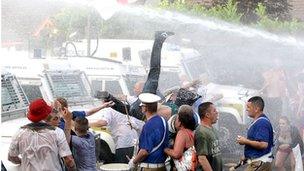Ardoyne, north Belfast: Eye of the storm
- Published

Loyalist rioting followed the decision to stop a parade returning along the Crumlin Road on 12 July
You usually hear the Pride of Ardoyne Flute Band before you see them.
One evening earlier this summer, I stood outside their band hall as they practised.
The sound of the drums reverberated around the streets of the loyalist Glenbryn estate in north Belfast.
Although I've lived in Belfast for four years, I'd never been to this part of the city before, and I was nervous.
This was to be my first meeting with a loyalist flute band. They don't usually entertain outsiders, and especially not TV camera crews.
And, as is often the case in Northern Ireland, there were other complications.
I'm a Catholic from the Republic of Ireland.
Loyalist flute bands like Pride of Ardoyne are staunchly Protestant and fiercely British, and in some people's eyes, anti-Catholic and sectarian.
I didn't know whether my background would be an issue for them.
I took a deep breath, opened the door, and stepped into another world. I didn't know then that two months later, I would be walking alongside this band as they marched into the eye of a storm.

More than 70 police officers were injured during the violence which started on 12 July
It all started with the idea of taking a look at the lives of young people in Northern Ireland 15 years after the signing of the Good Friday Agreement.
In many ways, that peace accord changed Northern Ireland beyond recognition.
Walk the streets of Belfast city centre today and you'll find a really vibrant place, with great nightlife and a strong local music and arts scene. Belfast is one of the youngest cities in the UK, and it feels that way.
The Troubles, which saw more than 3,500 people killed in the 1970s, 80s and 90s, seem like a long way away. I moved to Belfast four years ago to work for the BBC, and I've loved watching the city change and grow.
But then, late last year, something happened to break the spell - for me and for many others. Fierce rioting erupted in some loyalist communities, because the union flag was removed as a permanent fixture from Belfast City Hall.
Loyalists saw this as the ultimate insult, and the violence spread. For the first time, it came to my door - I spent an evening effectively trapped in my city centre flat as outside, cars were burned and petrol bombs thrown.
After that experience, I wanted to speak to young people on both sides of the religious divide in Northern Ireland, both Catholics and Protestants, to work out why so many young people seem so angry, despite having grown up with peace.
So I went to the area of Ardoyne in north Belfast, where the divisions are still all too apparent.
Here, young Catholics and Protestants still tend to stick to their own turf.
Flags, murals, and painted kerbstones tell you all you need to know about which area is which.
I was surprised at how deeply ingrained the divisions are in the area. Massive barricades called "peace walls" divide the two communities. No-one I spoke to wanted them taken down.
One of the most divisive issues in Ardoyne is loyalist marching. It's the catalyst for trouble here every summer.
Each year on 12 July, the Pride of Ardoyne band marches, as part of a 'feeder' parade for the main Orange demonstration in Belfast, along a road next to a Catholic estate.
Each year the feeder parade is met with protests by some residents of the Catholic estate, who regard the parade as sectarian. Later in the day, protests often turn to rioting.
This year, though, was different. For the first time, the band, and the rest of the feeder parade, were not allowed to walk home by their usual route along the stretch of the Crumlin Road that separates loyalist and nationalist communities.
Now it was the turn of loyalists to be outraged.

Police used water cannon in response
I was the only outsider permitted by Pride of Ardoyne band to walk with them on 12 July, and it was obvious there was going to be trouble.
When we approached police lines, where hundreds of riot police were deployed, the situation very quickly turned ugly.
We were caught in the middle as bricks and bottles were thrown. A police water cannon was brought out, and I found out what it is like to be on the wrong end of it.
It was chaos. The rioting continued for four nights and across Belfast, 71 police officers were injured.
Looking back, I found the inevitability of the violence, and the lack of talking between the two sides, to be quite depressing. As the missiles flew, it felt like a resolution to the issue of marching would be impossible.
Then a few days later, I was walking through Belfast city centre in the sunshine.
It's only three miles from Ardoyne but it feels like a different world. I remembered how far this city has come in the last 15 years.
And I thought: if that's possible, perhaps anything is.
But for that to happen, something has to change that will convince people to put down the petrol bombs, and start thinking about the next stage of Northern Ireland's peace.
- Published23 July 2013
- Published17 July 2013
- Published13 July 2013
- Published23 January 2013